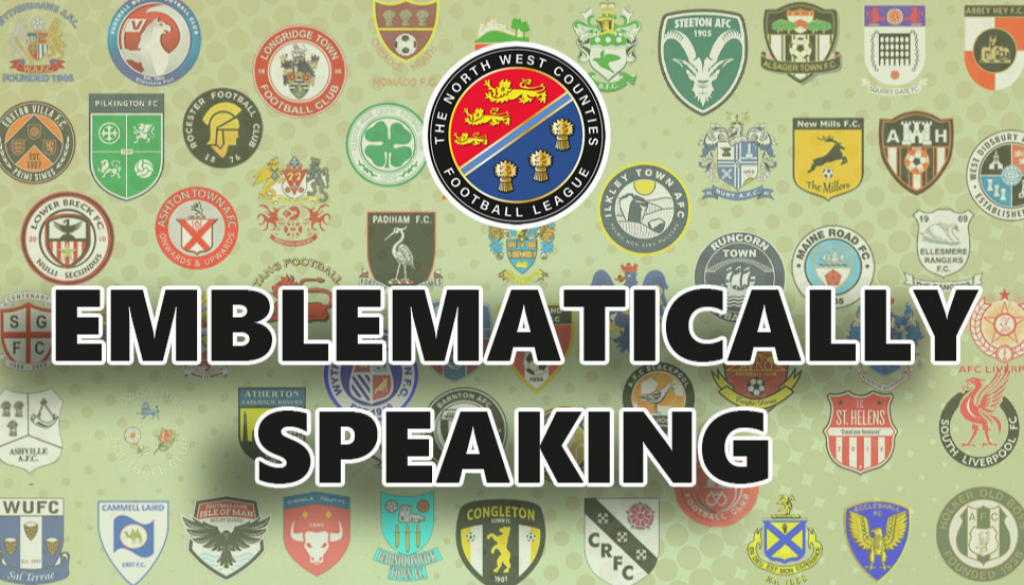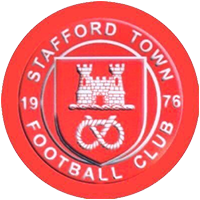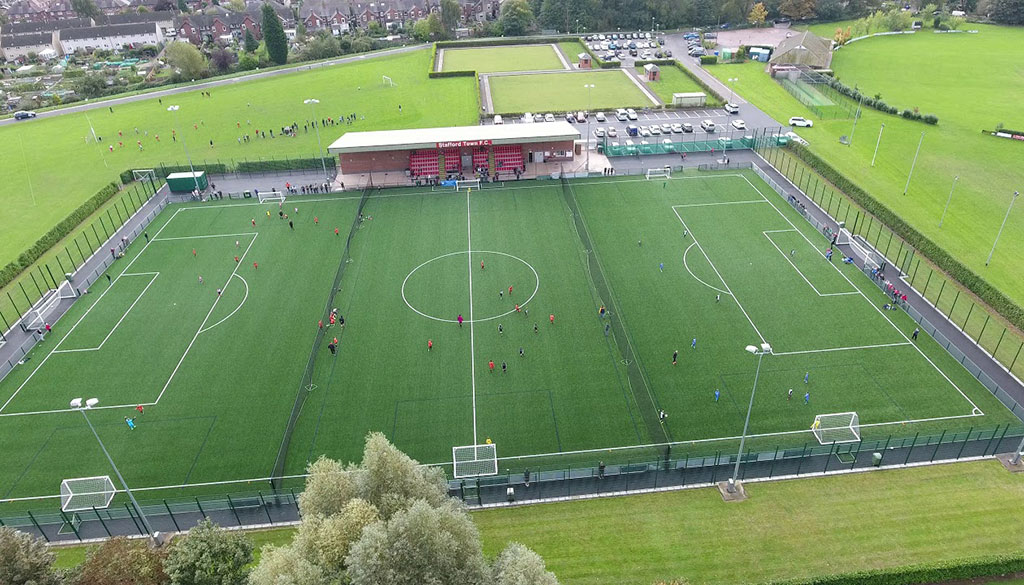
Emblematically Speaking - Stafford Town
Tue 11th April 2023 | Stafford Town | By Martin Fallon
As previously noted, the request for information elicited a splendid response from many clubs including from Dave Howard at Stafford Town. I can do no better than to pass over to Dave who goes through the history associated with the Stafford Town badge.
The Stafford Town badge is a very simple design with the team name ‘Stafford Town Football Club’ around the edge and the year of formation ‘1976’ separating the name.
The centre of the badge has two images with a representation of Stafford Castle above the Stafford Knott. The badge is Red representing the team’s first choice colours used by all 30+ sides within the Club.
Stafford Castle goes back over 900 years and, as might be expected over such a long period of time, has seen many changes. We will not explore the whole history of the castle during this article but simply say that a study of the development of the structure is really the story of influential families in the area. The castle has a Visitor Centre which goes into the detail of the history of the castle and has an exhibition of relevant historical artefacts.
The Stafford Knot, more commonly known as the Staffordshire knot, is a distinctive three-looped knot that is the traditional symbol of the English county of Staffordshire and of its county town, Stafford. It is a particular representation of the simple overhand knot, the most basic knot of all. The knot appears prominently on the flag of the historic county of Staffordshire, as well as on the banner of Staffordshire County Council. The motto of the county council — "the knot unites" — refers to the Stafford Knot.
Followers of this series of articles may recall that we featured the Stafford Knot in the Emblematically Speaking article on Hanley Town back in the first series and looked into the origins of the Knot. I unashamedly reproduce the relevant section from that article if only because I think it’s a good story.
One of the most popular stories of the Knot originated following the sentencing of three criminals to death by hanging in Stafford. However, when the executioner arrived to commit the grisly task, he came across a problem.
He only had one piece of rope. He could not just hang one of the criminals, and it would be unfair to the other two to give precedence to only one of the condemned.
He therefore tied his single rope into three loops and dispatched of all three criminals at the same time.
Another story of the Knot stems from the motto of Staffordshire: "The Knot Unites".
The Knot was said to symbolically bind three different local areas which joined to form what is now known as Staffordshire.
A more detailed account tells us of Ethelfleda, eldest daughter of Alfred the Great, who, more than a thousand years ago, defended a stronghold at Stafford.
She symbolically took off her girdle and said to the local lords: "With this girdle, I bind us all as one", and the three areas became Staffordshire.
The anniversary of this event was celebrated in 1913, a thousand years after it was said to have happened.
Nice stories - but is either of them the real story?
There's evidence to suggest that neither represent the true origin of the Knot, and that it comes from its presence on an Anglo-Saxon cross in a churchyard in Stoke-upon-Trent, and also on a 7th-century Anglo-Saxon object from the Staffordshire hoard.
This strongly suggests it pre-dates the Norman and medieval period, being probably either a heraldic symbol of early Mercia or a Celtic Christian symbol brought to Staffordshire by missionary monks from Lindisfarne.
As ever, the reader is invited to take their own preference as to the origins but any reference to the local de Stafford family will probably not help to define the origins of the Knot even though it is prominent on the family Coat of Arms. Equally, the resemblance to a pretzel is probably purely coincidental.
That the Knot is significant in the area is beyond question and we see it represented on the badges not only of football clubs but also many educational establishments.
Not for the first time we see charges of local significance depicted on football club badges and can look to the history behind such devices to understand better the links between a football club and the area in which it resides.
With grateful thanks to Dave Howard for his contribution to this article.
 Emblematically Speaking - Stafford Town
Emblematically Speaking - Stafford Town
Tue 11th April 2023 | Stafford Town
By Martin Fallon

As previously noted, the request for information elicited a splendid response from many clubs including from Dave Howard at Stafford Town. I can do no better than to pass over to Dave who goes through the history associated with the Stafford Town badge.
The Stafford Town badge is a very simple design with the team name ‘Stafford Town Football Club’ around the edge and the year of formation ‘1976’ separating the name.
The centre of the badge has two images with a representation of Stafford Castle above the Stafford Knott. The badge is Red representing the team’s first choice colours used by all 30+ sides within the Club.
Stafford Castle goes back over 900 years and, as might be expected over such a long period of time, has seen many changes. We will not explore the whole history of the castle during this article but simply say that a study of the development of the structure is really the story of influential families in the area. The castle has a Visitor Centre which goes into the detail of the history of the castle and has an exhibition of relevant historical artefacts.
The Stafford Knot, more commonly known as the Staffordshire knot, is a distinctive three-looped knot that is the traditional symbol of the English county of Staffordshire and of its county town, Stafford. It is a particular representation of the simple overhand knot, the most basic knot of all. The knot appears prominently on the flag of the historic county of Staffordshire, as well as on the banner of Staffordshire County Council. The motto of the county council — "the knot unites" — refers to the Stafford Knot.
Followers of this series of articles may recall that we featured the Stafford Knot in the Emblematically Speaking article on Hanley Town back in the first series and looked into the origins of the Knot. I unashamedly reproduce the relevant section from that article if only because I think it’s a good story.
One of the most popular stories of the Knot originated following the sentencing of three criminals to death by hanging in Stafford. However, when the executioner arrived to commit the grisly task, he came across a problem.
He only had one piece of rope. He could not just hang one of the criminals, and it would be unfair to the other two to give precedence to only one of the condemned.
He therefore tied his single rope into three loops and dispatched of all three criminals at the same time.
Another story of the Knot stems from the motto of Staffordshire: "The Knot Unites".
The Knot was said to symbolically bind three different local areas which joined to form what is now known as Staffordshire.
A more detailed account tells us of Ethelfleda, eldest daughter of Alfred the Great, who, more than a thousand years ago, defended a stronghold at Stafford.
She symbolically took off her girdle and said to the local lords: "With this girdle, I bind us all as one", and the three areas became Staffordshire.
The anniversary of this event was celebrated in 1913, a thousand years after it was said to have happened.
Nice stories - but is either of them the real story?
There's evidence to suggest that neither represent the true origin of the Knot, and that it comes from its presence on an Anglo-Saxon cross in a churchyard in Stoke-upon-Trent, and also on a 7th-century Anglo-Saxon object from the Staffordshire hoard.
This strongly suggests it pre-dates the Norman and medieval period, being probably either a heraldic symbol of early Mercia or a Celtic Christian symbol brought to Staffordshire by missionary monks from Lindisfarne.
As ever, the reader is invited to take their own preference as to the origins but any reference to the local de Stafford family will probably not help to define the origins of the Knot even though it is prominent on the family Coat of Arms. Equally, the resemblance to a pretzel is probably purely coincidental.
That the Knot is significant in the area is beyond question and we see it represented on the badges not only of football clubs but also many educational establishments.
Not for the first time we see charges of local significance depicted on football club badges and can look to the history behind such devices to understand better the links between a football club and the area in which it resides.
With grateful thanks to Dave Howard for his contribution to this article.




